communication through speech
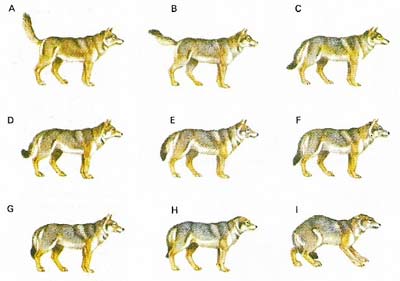
Figure 1. Wolves, like humans, form integrated social groups and have a flexible communication system to express both emotions and status within the hierarchy of the family pack. Apart from vocal noises and facial or body positions, a wolf can use its tail to indicate confidence (A), confident threat (B), relaxation (C), uncertain threat (D), relaxed feeding (E), depression (F), defensive threat (G), active submission with wagging (H), and abject submission (I).
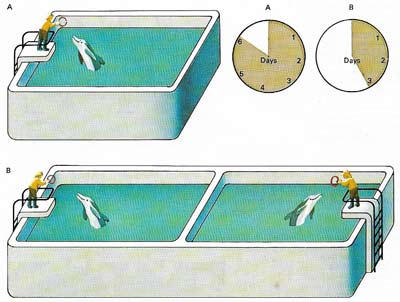
Figure 2. Dolphins communicate with each other by a system of distinct sounds ranging from clicks to whistles. These highly developed marine mammals can also locate small objects from relatively long distances by sending and receiving echo-locating pulses. To test the ability of dolphins to communicate information through sound codes, scientists noted the time a dolphin took to learn a trick (A). The skilled dolphin was then placed in a tank alongside an unskilled one which could hear but not see it (B). In all tests the second dolphin learned to perform the trick much faster, apparently because it was being prompted by sound messages.

Figure 3. Chimpanzees have been taught a rudimentary vocabulary as a result of experiments conducted in the US since the early 1950s. In attempting to find out if animals could be thought to communicate directly with man, scientists chose the chimpanzee both because its physical and mental capacity are closest to those of humans and because it is able to form strong emotional ties with them. In early experiments efforts were made to teach spoken words to a chimpanzee reared from birth with a family. But it managed to learn only four words. More recent experiments have used systems of geometric shapes or hand signs. Having noticed the use of gestures by chimpanzees in the wild, one researcher adopted a year-old animal into his family and began teaching it American sign language, a system used widely by the deaf. By instruction through play the chimpanzee steadily amassed a vocabulary of signs. Seen here are the signs for a listen (A), eat (B) and toothbrush (C). After four years of study it knew about 150 signs and began to use them in combinations to form meanings. Signs for bird and water were used to represent a duck, for instance. The sign for dirty, which previously had been used only about soiled objects, was combined with monkey when the chimpanzee described a macaque that threatened it. Researchers are now investigating whether chimpanzees will use learned sign language between themselves.
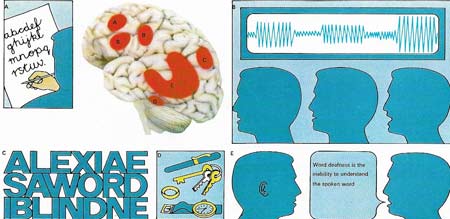
Figure 4. Language control areas in the brain are vital for several different functions. Writing ability is located in the frontal lobe (A), together with two areas that control voice production (B). Alexia, a form of word blindness in which letters are confused, can result from damage to an area of the parietal lobe (C), while deafness can result from damage to the cortex of the parietal and temporal lobes where ability to comprehend the spoken word is located (E). Another area of the temporal lobe apparently controls the ability to name things correctly (D). In most people, the processes are controlled in the brain's left hemisphere.
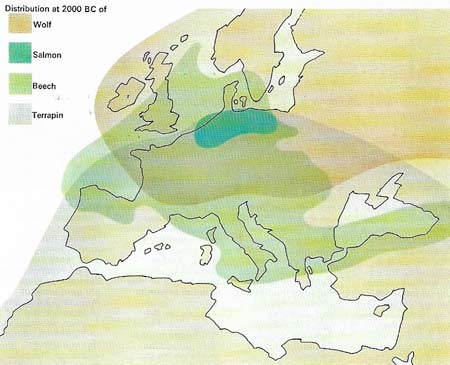
Figure 5. Language detective work by scholars and scientists has led to the theory that an area of northern Europe was the place of origin for all the languages of the vast Indo-European group. The names of a small group of plants and animals are similar in all these tongues. But fossil dating techniques indicate that before 2000 BC only one area, close to the shores of the Baltic, provided a habitat for all four species: wolf, salmon, terrapin, and beech tree. The theory is that a race of people spread out from this area imposed their own names for the species another tongues, but adopted various local names for species with which they were unfamiliar.

Figure 6. International organizations are the modern Towers of Babel. At the UN every speech, no matter what its original language, is simultaneously translated into the five official languages – Chinese, English, French, Russian, and Spanish.
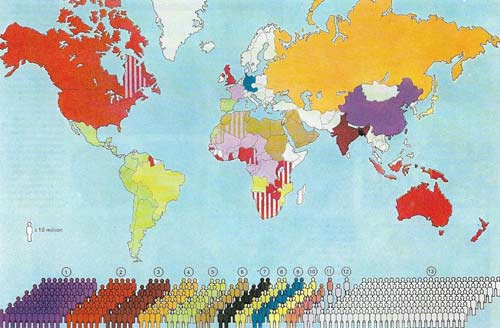
Figure 7. Each of the world's 8 billion people belongs to a speech community, a group speaking the same language. About 1,500 different languages are spoken, the largest block being Mandarin Chinese, but this does not include those speaking Wu, Cantonese, and other Chinese tongues. The map shows the 12 principal official languages throughout the world. The rest of the world is split into smaller language blocks such as Italian, Tamil, Korean, Punjabi, Dutch and Flemish. and Greek. About 100 languages have more than one million speakers. A multiplicity of other languages are each spoken by a smaller number of people than this. Superimposed on the thousands of local languages and dialects around the world are the six major international languages of the historic colonialist powers: English, Spanish, Russian, Arabic, Portuguese and French. Easy communications may increase the dominance of some of these languages, and of Japanese and Chinese, as mediums of commerce, education and cultural exchange. The Indo-European group of languages is the most widespread. More people now speak these languages outside Europe than inside it. North America has the biggest English-speaking population and South America has most speakers of Spanish. A growing number of people throughout the world can speak one of the major international languages as well as their native tongue. At the same time, the number of speakers of minority tongues is steadily dwindling. Efforts to establish an artificially created language such as Esperanto have been limited by the fact that such languages lack a cultural base. 1 Mandarin Chinese 2 English 3 Hindi and Urdu 4 Russian 5 Spanish 6 Arabic 7 Bengali 8 Portuguese 9 German 10 Japanese 11 Indonesian 12 French 13 Other languages

Figure 8. The speech organs consist of the lungs, larynx, nasal cavity, tongue, mouth and lips. Speech begins with voice production as the lungs push air through the larynx. During normal breathing the vocal cords (1) in the larynx are held apart forming a triangular opening (2). When speech begins, the articulating cartilages of the larynx are drawn together by muscular action (3) and a linear chink is left between the vocal cords. The faster air is forced through this chink, the louder the voice. The pitch of the voice depends on the tension of the vocal cords and the parts of the cords that are made to vibrate. When the articulating cartilages (4) are tilted (5) changes are caused in cord tension. The tighter the cords, the higher the note produced in the larynx. As air passes through the mouth the voice is modulated and broken up by changes in the shape and position of the other organs.
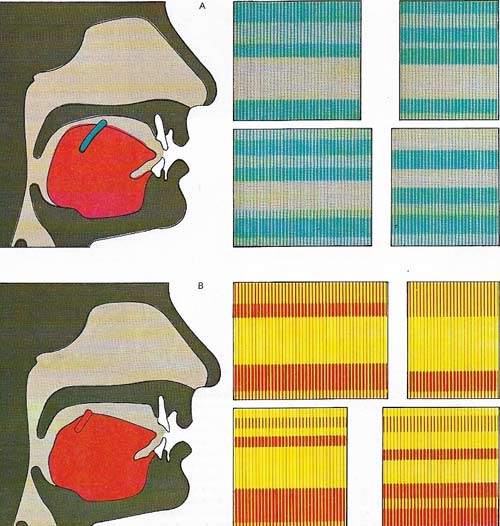
Figure 9. The sound spectrograph analyses the sound waves made by speech into component frequencies and intensities. A spectrogram is produced on electrically sensitized paper on which a registering stylus burns dark traces to sheathe concentration of energy in the appropriate frequency areas. The tongue position that produces spectrograms of front vowels (A) is slightly different from that which produces back vowels (E). No two vowel patterns are exactly alike; the significant variations are seen in the position of the resonance bate – the darkest horizontal bands. Each person produces a distinctive spectrogram because the number of permutations in voice production are infinite, involving about 100 paired and single muscles and dependent on very delicate adjustments in the air currents escaping from the lungs. All this is associated with contraction of internal and external muscles of the larynx to maintain the margins of the glottis at the right degree of elasticity. The complex sound wave produced by regular vibrations of the glottal folds consists of a basic vibration (called the fundamental, related to our perception of pitch) and a series of over-tones. The relative pitches and ranges of these overtones determine the quality and the character of the voice produced. In speech and song, sounds (usually initiated by lung air, with or without glottal vibration) are modified by the shape of the resonators provided especially by the pharynx, the nasal cavities and the mouth, which is particularly flexible and important in "molding" the emerging stream of air. An individual spectrogram is unique, as is a fingerprint, although perhaps more variable, opening the way for the use of "voice-prints" as a means of identification.
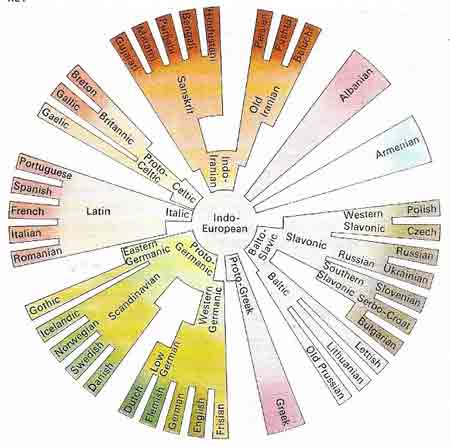
Figure 10. Connections between different languages.
Any system used by a social group to communicate information, whether drum beats, smoke signals, or finger movements, may loosely be called a language. But of all language forms that exist by far the most flexible and expressive is human speech.
Origins of speech
Language and thought are so intertwined that it is sometimes forgotten that men originally had to learn to talk to each other by inventing arbitrary vocal symbols for a whole world of nameless objects, actions and emotions. The idea of naming things is assumed to have evolved from more simple forms of communication such as gestures, facial and bodily movements and the kind of cries, grunts, snorts, whistles, or clicks uttered by animals or birds (Figure 1). Experiments with animals ranging from apes to dolphins have shown that some are capable of imitating human speech or of responding to a limited number of sounds (Figures 2 and 3). The crucial difference between speech and animal communication is man's ability to cope with complicated ideas, particularly involving time and space.
It seems certain that language and thought evolved together, one quickening the other. Man's ability to perpetuate and extend his knowledge gave him the power of swift cultural development, increasing his dominance over other animals. The idea that language was originally a divine gift appears in many mythologies.
Although the different shape of man's vocal organs allows him to make more varied sounds than the hominoid ape, his linguistic superiority is primarily an intellectual one. Every normal child appears to be born with the capacity to learn a language simply by watching and listening to people around him. Since few sentences are ever repeated in precisely the same way, this remarkable achievement implies an innate faculty not only to learn words and their meanings but also to grasp grammatical structure at a deep level.
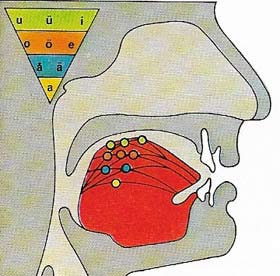 |
| Vowel sounds are controlled largely by the position of the tongue in the mouth. A triangle diagram named after the scientist who originally formulated it, Hellwag, represents the limits of the tongue positions for the major vowels, although these vary slightly for different languages. Depending on their vertical position, vowels are classified as front, central or back, while the horizontal classification is closed, half-closed, half-open, and open. |
The question of whether all languages descend from one common source language or rather evolved among separate groups independently in different parts of the world is impossible to determine. The length of man's history, the transitory nature of early cultures which must have possessed language, and the superimposition of later tongues through trade or invasion, have all weakened the scent.
Linguistic studies, on the other hand, have shown that one historic language, Indo-European, has been the parent of existing languages spoken by about half the world's population. In western Europe only one regional tongue, Basque, is not descended from it. Further investigation of a small group of words for plants and animals that had a common origin (Figure 5) narrowed down the geographical origin of the proto-language to a small area of northern Europe from which chariot-riding marauders began to spread out in about 2000 BC, mingling their language with those of the lands they reached.
Limitations and resources
Each particular language conditions a speaker's way of seeing the world and of feeling and acting in it. The limitations of language have preoccupied many twentieth-century writers and thinkers. At the same time, the film image has become, through cinema and television, an important supplement to language as a cultural tool. Yet the influence of spoken language on man's development remains fundamental. Only through language can people communicate diversities of meaning with sufficient precision to allow complex social, economic and cultural systems to work.
Vocabulary itself is only one of an armory of speech weapons. Variations in word selection and sentence structure, intonation and emphasis, can convey infinite nuances. When supplemented by facial expression and gesture, language becomes more expressive still. The Russian actor-manager Konstantin Stanislaysky (1865–1938) used to ask his students to say the word "tonight" in 50 different ways, ranging from inquiry, surprise, and doubt to rage, fear, relief, and excitement.
When we speak we do not utter words but what may be termed "breath groups" – an uninterrupted flow of breath that is often less than a sentence (depending sometimes on lung capacity). Listeners understand three things: logical value as indicated by choice, order, emphasis; intonation; and something beyond that which word symbols convey. The study of meaning at its deepest level is the most complicated and difficult aspect of language study, not only because of the diversity of human thought and experience but also because the vocabulary of a living language may change rapidly while grammatical and phonetic changes evolve slowly.
The analysis of language
Grammar is the description of the structure of a language and has two necessary subjects: the sounds and the meaningful combinations of sounds. The sounds are studied in phonetics. The description of the meaningful terms is the morphology; a minimal meaningful unit is the morpheme. For example, "man" is a basic morpheme from which "manly" and "manliness" are derived. In English, a free entity of one or more morphemes bound together is a word. The study of the history, development and origin of words is called etymology; the arrangements of words is called syntax. Semantics is the study of the meaning of language.
More than 4,000 languages, living or dead, have been identified. The migration of early nomadic peoples produced an astonishing diversity of speech forms as each group experimented with language, discovering new things to be named, borrowing words from other tribes and slowly changing the sound and the grammatical construction of its own tongue in so doing.
How languages are classified
Nearly half the population of the world speaks one of the Indo-European group of languages (Figure 10), all of which derive from a common tongue spoken in northern Europe about 5,000 years ago. But the language divided into eight major branches, five of which split and resplit as words were shortened, lengthened, coined or swopped, as syllables were added or dropped and as vowels and consonants changed. Because Eastern peoples, for example, were not accustomed to pronouncing the Aryan sound "k", they altered it to "s" or "sh" when invaders from the West settled amongst them. As grammatical changes were made, the original links became obscured.
A few languages, called isolates, seem unrelated to others; Basque is an example. But some features of grammatical structure are common to all forms of speech and many languages are historically related. Classification of the difference between them is of two kinds: genetic and typological. Genetic classification is based on word derivation, common history and literary traditions and on sociocultural factors. Within the Indo-European family of languages genetic classification identifies such sub-families as the German, English, Dutch, Swedish, Norwegian and Danish group.
Typological classification groups languages according to their structure as isolating, agglutinating and inflecting types. An isolating language is one that indicates grammar mainly by word order with each word being a single grammatical unit called a morph. Vietnamese is an example. An agglutinating language is one in which individual words can be composed of several morphs glued together, as in Turkish. An inflecting language is one in which there is no specific correspondence between particular segments of a word and particular grammatical functions. An example is the English word "mice" in which plurality is indicated by a syllable change instead of an added morph. English, like many languages, combines all three typological features.
Differences within languages
Adding to the enormous diversity of language are the subtleties of accent and tonal change that can be produced by the speech organs (Fig 8). Even within a single language there are subdivisions, or dialects, based on regional, social or occupational differences. There are American, Australian and Scottish dialects of English, for example. They contrast with Gaelic, which is quite a different language from Scottish English, although the two may be spoken within the same Highland village. The point at which dialects become separate languages is not always clear. The Dutch-German speech community, for example, spans a continuous area of intelligibility from Flanders (Dutch) to Styria (German), but speakers of Flemish and Styrian dialects cannot understand each other.
Social groups may use speech differences to heighten group identity, to exclude others speaking the same language or to underline social divisions by the snobbery of a preferred accent. When extended to political or international rivalry the divisive aspects of language can be dangerous. In India, for example, the end of British rule led to rioting over whether Hindi (an Indo-European tongue) or one of the earlier Dravidian tongues, such as Tamil, should become the country's official language. Similarly, language rivalry in Belgium and Canada has also caused political tension.
The potential of language as a unifying force was recognized by the Romans who used Latin in the west and Greek in the east of their empire to weld together the peoples they controlled. Latin provided scholars throughout medieval Europe with a lingua franca (common language) and survives today both in professions such as law and medicine and as a source for new scientific words. The prestige of France and the clarity of its language made French the language of European diplomacy for many years, while in the 20th century the dominance of English-speaking peoples in technology and commerce has led to increasing interest in the acquisition of English as a second language.
Improving communication
A simplified language form called pidgin was used by several European nations to facilitate trade or to communicate with peoples they colonized. At a more sophisticated level there have been at least 300 attempts to invent a universal language of which Esperanto alone (with more than 750,000 speakers) has made some headway.
A whole range of languages has also been developed for computers. These codes are made up of unambiguous words and symbols. The message is first translated into the special language. A typical example in COBOL (Common Business Oriented Language) might read "Multiply hours-worked by rate-for-job giving wage-payable". This is fed into the machine, which translates it into basic instructions that trigger further commands to the machine and produce the result.


